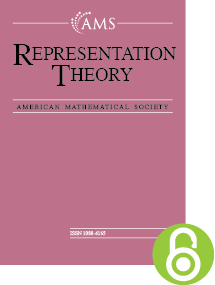Pieces of nilpotent cones for classical groups
HTML articles powered by AMS MathViewer
- by Pramod N. Achar, Anthony Henderson and Eric Sommers
- Represent. Theory 15 (2011), 584-616
- DOI: https://doi.org/10.1090/S1088-4165-2011-00393-9
- Published electronically: August 22, 2011
- PDF | Request permission
Abstract:
We compare orbits in the nilpotent cone of type $B_n$, that of type $C_n$, and Kato’s exotic nilpotent cone. We prove that the number of $\mathbb {F}_q$-points in each nilpotent orbit of type $B_n$ or $C_n$ equals that in a corresponding union of orbits, called a type-$B$ or type-$C$ piece, in the exotic nilpotent cone. This is a finer version of Lusztig’s result where corresponding special pieces in types $B_n$ and $C_n$ have the same number of $\mathbb {F}_q$-points. The proof requires studying the case of characteristic $2$, where more direct connections between the three nilpotent cones can be established. We also prove that the type-$B$ and type-$C$ pieces of the exotic nilpotent cone are smooth in any characteristic.References
- Pramod N. Achar and Anthony Henderson, Orbit closures in the enhanced nilpotent cone, Adv. Math. 219 (2008), no. 1, 27–62. MR 2435419, DOI 10.1016/j.aim.2008.04.008
- Roger W. Carter, Finite groups of Lie type, Pure and Applied Mathematics (New York), John Wiley & Sons, Inc., New York, 1985. Conjugacy classes and complex characters; A Wiley-Interscience Publication. MR 794307
- David H. Collingwood and William M. McGovern, Nilpotent orbits in semisimple Lie algebras, Van Nostrand Reinhold Mathematics Series, Van Nostrand Reinhold Co., New York, 1993. MR 1251060
- Meinolf Geck and Götz Pfeiffer, Characters of finite Coxeter groups and Iwahori-Hecke algebras, London Mathematical Society Monographs. New Series, vol. 21, The Clarendon Press, Oxford University Press, New York, 2000. MR 1778802
- R. Groszer, Degenerationsverhalten nilpotenter Konjugationsklassen klassischer Lie-Algebren in Charakteristic 2, dissertation, Bonn 1980.
- Wim H. Hesselink, Nilpotency in classical groups over a field of characteristic $2$, Math. Z. 166 (1979), no. 2, 165–181. MR 525621, DOI 10.1007/BF01214043
- Syu Kato, An exotic Deligne-Langlands correspondence for symplectic groups, Duke Math. J. 148 (2009), no. 2, 305–371. MR 2524498, DOI 10.1215/00127094-2009-028
- —, Deformations of nilpotent cones and Springer correspondences, Amer. J. Math. 133 (2011), no. 2, 519–553. MR 2797355
- Hanspeter Kraft and Claudio Procesi, A special decomposition of the nilpotent cone of a classical Lie algebra, Astérisque 173-174 (1989), 10, 271–279. Orbites unipotentes et représentations, III. MR 1021514
- G. Lusztig, Green polynomials and singularities of unipotent classes, Adv. in Math. 42 (1981), no. 2, 169–178. MR 641425, DOI 10.1016/0001-8708(81)90038-4
- George Lusztig, Character sheaves. V, Adv. in Math. 61 (1986), no. 2, 103–155. MR 849848, DOI 10.1016/0001-8708(86)90071-X
- G. Lusztig, Notes on unipotent classes, Asian J. Math. 1 (1997), no. 1, 194–207. MR 1480994, DOI 10.4310/AJM.1997.v1.n1.a7
- G. Lusztig, Unipotent elements in small characteristic, Transform. Groups 10 (2005), no. 3-4, 449–487. MR 2183120, DOI 10.1007/s00031-005-0405-1
- G. Lusztig, Unipotent elements in small characteristic. II, Transform. Groups 13 (2008), no. 3-4, 773–797. MR 2452615, DOI 10.1007/s00031-008-9021-1
- —, Unipotent elements in small characteristic III, with an appendix by G. Lusztig and T. Xue, J. Algebra 329 (2011), 163–189. doi:10.1016/j.jalgebra.2009.12.008, MR 2769321
- I. G. Macdonald, Symmetric functions and Hall polynomials, 2nd ed., Oxford Mathematical Monographs, The Clarendon Press, Oxford University Press, New York, 1995. With contributions by A. Zelevinsky; Oxford Science Publications. MR 1354144
- Toshiaki Shoji, On the Springer representations of the Weyl groups of classical algebraic groups, Comm. Algebra 7 (1979), no. 16, 1713–1745. MR 546195, DOI 10.1080/00927877908822425
- T. Shoji, On the Green polynomials of classical groups, Invent. Math. 74 (1983), no. 2, 239–267. MR 723216, DOI 10.1007/BF01394315
- Toshiaki Shoji, Green functions attached to limit symbols, Representation theory of algebraic groups and quantum groups, Adv. Stud. Pure Math., vol. 40, Math. Soc. Japan, Tokyo, 2004, pp. 443–467. MR 2074601, DOI 10.2969/aspm/04010443
- Nicolas Spaltenstein, Classes unipotentes et sous-groupes de Borel, Lecture Notes in Mathematics, vol. 946, Springer-Verlag, Berlin-New York, 1982 (French). MR 672610, DOI 10.1007/BFb0096302
- Nicolas Spaltenstein, Nilpotent classes and sheets of Lie algebras in bad characteristic, Math. Z. 181 (1982), no. 1, 31–48. MR 671712, DOI 10.1007/BF01214979
- T. A. Springer, Linear algebraic groups, 2nd ed., Progress in Mathematics, vol. 9, Birkhäuser Boston, Inc., Boston, MA, 1998. MR 1642713, DOI 10.1007/978-0-8176-4840-4
- T. A. Springer, The exotic nilcone of a symplectic group, J. Algebra 321 (2009), no. 11, 3550–3562. MR 2510061, DOI 10.1016/j.jalgebra.2008.08.013
- M. Sun, Point stabilisers for the enhanced and exotic nilpotent cones, to appear in J. Group Theory, arXiv:0909.0356v3.
- Ting Xue, Nilpotent orbits in classical Lie algebras over finite fields of characteristic 2 and the Springer correspondence, Represent. Theory 13 (2009), 371–390. MR 2540701, DOI 10.1090/S1088-4165-09-00357-4
- —, Combinatorics of the Springer correspondence for classical Lie algebras and their duals in characteristic $2$, arXiv:0911.1350v1.
- —, On unipotent and nilpotent pieces, arXiv:0912.3820v1.
Bibliographic Information
- Pramod N. Achar
- Affiliation: Department of Mathematics, Louisiana State University, Baton Rouge, Louisianna 70803-4918
- MR Author ID: 701892
- Email: pramod@math.lsu.edu
- Anthony Henderson
- Affiliation: School of Mathematics and Statistics, University of Sydney, NSW 2006, Australia
- MR Author ID: 687061
- ORCID: 0000-0002-3965-7259
- Email: anthony.henderson@sydney.edu.au
- Eric Sommers
- Affiliation: Department of Mathematics and Statistics, University of Massachusetts, Amherst, Massachusetts 01003-4515
- Email: esommers@math.umass.edu
- Received by editor(s): January 24, 2010
- Received by editor(s) in revised form: June 30, 2010
- Published electronically: August 22, 2011
- Additional Notes: The first author’s research was supported by Louisiana Board of Regents grant NSF(2008)-LINK-35 and by National Security Agency grant H98230-09-1-0024.
The second author’s research was supported by Australian Research Council grant DP0985184. - © Copyright 2011
American Mathematical Society
The copyright for this article reverts to public domain 28 years after publication. - Journal: Represent. Theory 15 (2011), 584-616
- MSC (2010): Primary 17B08, 20G15; Secondary 14L30
- DOI: https://doi.org/10.1090/S1088-4165-2011-00393-9
- MathSciNet review: 2833469


